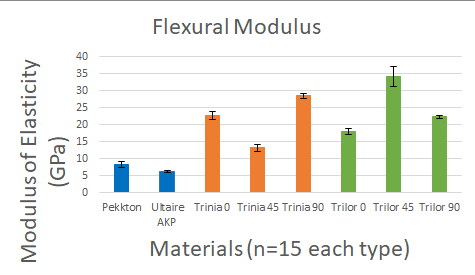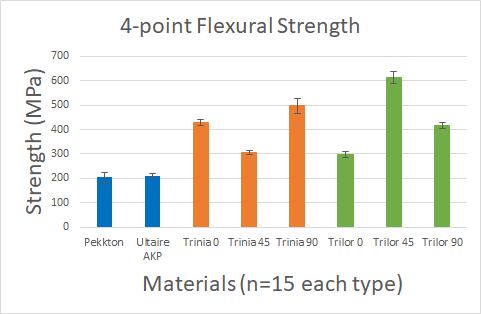IADR Abstract Archives
Evaluation of Flexural Strength of Removable Partial Denture Materials
Objectives: Metal-free removable partial denture (RPD) frameworks have become increasingly popular due to their enhanced aesthetics, comfort, fit, and function. This study evaluated the flexural strength and flexural modulus of various milled RPD framework materials.
Methods: Four RPD materials were studied: Trinia (Shofu Dental Corp., San Marcos, CA), Trilor (Preat Corp., Santa Maria, CA), Pekkton (anaxdent North America, Ardmore, OK), and Ultaire AKP (Solvay Specialty Polymers, Greenville, SC). The as-received milling pucks were sectioned into 2.0-mm-thick plates using a water-cooled diamond saw. The Trinia and Trilor pucks (both fiber-reinforced) had additional plates prepared by cutting at 45° and 90° from the first section. Following ISO 4049, N=15 2.0×2.0×25mm specimen micro-tensile bars were fabricated from the plates. An ElectroPuls E-3000 (Instron, Norwood, MA) was used to perform four-point bend testing at a crosshead speed of 0.5 mm/min over a test span of 20.0 mm. Flexural strength and flexural modulus were calculated, and the results were analyzed using one-way ANOVA and a post-hoc Tukey test using statistical software (SPSS) (α=0.05).
Results: Strength and modulus data are shown in the figures below. Pekkton had a mean flexural strength of 204 MPa and a flexural modulus of 8.3 GPa. Similarly, Ultaire AKP had a flexural strength of 209 MPa with 6.1 GPa modulus. Both Trinia and Trilor demonstrated different strength and modulus for different cutting orientations. Trinia’s strength ranged from 304.8MPa to 496.6 MPa and its modulus ranged from 13.1 GPa to 28.4 GPa. Meanwhile, Trilor’s strength ranged from 298.2 MPa to 611 MPa and its modulus ranged from 17.8 GPa to 34 GPa. Specimens of Trinia 45 and Trilor 0 bent, but did not break during testing. Both ANOVAs reveal significance between-group differences in strength (p<0.001) and modulus (p<0.001).
Conclusions: Fiber-reinforced materials (Trinia and Trilor) had significantly higher strength and modulus than those without fibers (Pekkton and Solvay). Both fiber-reinforced materials displayed a high degree of anisotropy.
Methods: Four RPD materials were studied: Trinia (Shofu Dental Corp., San Marcos, CA), Trilor (Preat Corp., Santa Maria, CA), Pekkton (anaxdent North America, Ardmore, OK), and Ultaire AKP (Solvay Specialty Polymers, Greenville, SC). The as-received milling pucks were sectioned into 2.0-mm-thick plates using a water-cooled diamond saw. The Trinia and Trilor pucks (both fiber-reinforced) had additional plates prepared by cutting at 45° and 90° from the first section. Following ISO 4049, N=15 2.0×2.0×25mm specimen micro-tensile bars were fabricated from the plates. An ElectroPuls E-3000 (Instron, Norwood, MA) was used to perform four-point bend testing at a crosshead speed of 0.5 mm/min over a test span of 20.0 mm. Flexural strength and flexural modulus were calculated, and the results were analyzed using one-way ANOVA and a post-hoc Tukey test using statistical software (SPSS) (α=0.05).
Results: Strength and modulus data are shown in the figures below. Pekkton had a mean flexural strength of 204 MPa and a flexural modulus of 8.3 GPa. Similarly, Ultaire AKP had a flexural strength of 209 MPa with 6.1 GPa modulus. Both Trinia and Trilor demonstrated different strength and modulus for different cutting orientations. Trinia’s strength ranged from 304.8MPa to 496.6 MPa and its modulus ranged from 13.1 GPa to 28.4 GPa. Meanwhile, Trilor’s strength ranged from 298.2 MPa to 611 MPa and its modulus ranged from 17.8 GPa to 34 GPa. Specimens of Trinia 45 and Trilor 0 bent, but did not break during testing. Both ANOVAs reveal significance between-group differences in strength (p<0.001) and modulus (p<0.001).
Conclusions: Fiber-reinforced materials (Trinia and Trilor) had significantly higher strength and modulus than those without fibers (Pekkton and Solvay). Both fiber-reinforced materials displayed a high degree of anisotropy.


